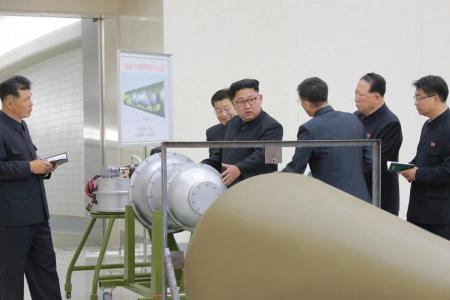Expert: North Korea's bomb 'capable of destroying cities'
Evidence suggests Pyongyang has successfully developed nuclear weapon
SEOUL North Korea's claim of a successful hydrogen bomb test marks a major step in the isolated country's long-stated goal of developing a nuclear-tipped missile that puts the US mainland within range, experts said.
North Korea conducted its sixth and most powerful nuclear test yesterday, which it said was a successful detonation of an advanced hydrogen bomb, technically known as a two-stage thermonuclear device.
All of North Korea's six nuclear tests, including yesterday's, took place at its underground testing site in Punggye-ri.
It is not easy to independently verify the claims but experts who studied the earthquake caused by the explosion - measuring a magnitude of 6.3 - said there was enough strong evidence to suggest the North has either developed a hydrogen bomb or is getting very close.
Norsar, a Norwegian earthquake monitoring agency, estimated the yield at 120 kilotons, significantly above the 15 kiloton "Little Boy" bomb dropped on Hiroshima and the 20 kiloton "Fat Man" dropped on Nagasaki at the end of World War II.
North Korea claims its intercontinental ballistic missiles (ICBMs) tested twice in July can reach parts of the mainland US.
Experts said it likely achieved that only by topping the test missile with a payload lighter than any nuclear warhead it has been able to produce so far.
Developing a hydrogen bomb would be key to a lighter warhead, because that would offer much greater explosive yield relative to size and weight.
"Getting this high of a yield would likely require thermonuclear material in the device," said physicist David Albright, founder of the non-profit Institute for Science and International Security in Washington.
"It would show their design has achieved a yield capable of destroying modern cities."
A hydrogen bomb usually uses a primary atomic bomb to trigger a larger explosion.
Such a weapon, with the first stage based on nuclear fission - splitting atoms - and the second on nuclear fusion, produces much more power than traditional atomic bombs, or "pure fission" devices.
Hours before the latest test, North Korean state media published photographs of leader Kim Jong Un inspecting a peanut-shaped device that it said was a hydrogen bomb designed to be loaded on a new ICBM.
The elongated shape of the device shows a difference from pictures of the ball-shaped device North Korea released in March last year, and appears to indicate the appearance of a two-stage thermonuclear weapon, experts said. - REUTERS
Get The New Paper on your phone with the free TNP app. Download from the Apple App Store or Google Play Store now


